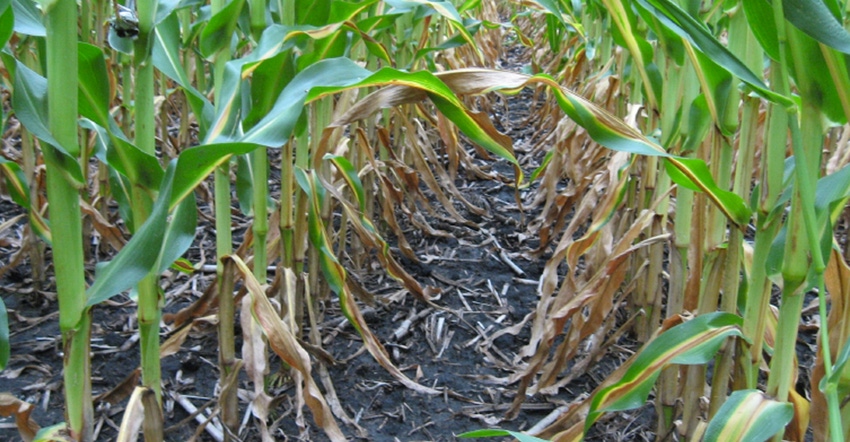April 23, 2020

You may notice telltale signs of nutrient deficiency as you scout corn and soybean fields this season. Unfortunately, some yield is already lost once visible signs of deficiencies are noticed. Though a rescue nutrient application may help, finding a deficiency is best used as an opportunity to learn and make adjustments for next year.
“You can start planning for any necessary fall fertilizer application or crop nutrition needs next spring by collecting field data and associated location information,” says Curt Woolfolk, senior agronomist with Mosaic Co. “There are common visible patterns to look for when scouting to help identify different nutrient deficiencies that can affect a crop.”
Corn deficiencies
Woolfolk lists the following deficiencies that can be found in corn:
Nitrogen. With nitrogen deficiencies in corn, yellowing first appears at the tip of the leaf, and then extends toward the center of the leaf (midrib). Imagine taking a diamond shape, grabbing two opposing corners and stretching the shape. Patterns like this that are pale yellow in the lower, older leaves are good indicators of nitrogen deficiency.
Sulfur. Sulfur and nitrogen deficiencies are often confused with one another. Sulfur deficiencies will show up as yellowing, similar to nitrogen, but are found in the younger upper leaves due to immobility within the plant. “We typically see sulfur deficiencies on sandy, low-organic-matter soil or cold, dry soils in spring,” Woolfolk says.
Soybean deficiencies
Most soybean nutrient deficiencies will appear in the early stages of growth — from the first trifoliate through the R1 stage — or when the plant begins to flower. All nutrient deficiencies in soybeans appear as a change in color, which often includes yellowing of leaves.
Pay close attention to which leaves are carrying a lighter-green or yellow color. Color change on lower leaves can signify a different nutrient deficiency than leaves on top of the plant. For example, potassium deficiencies appear on lower, older leaves of the soybean plant, while manganese deficiencies appear on the top, younger leaves.
 POTASSIUM DEFICIENCY: All nutrient deficiencies in soybeans appear as a change in color, often it is yellowing of leaves.
POTASSIUM DEFICIENCY: All nutrient deficiencies in soybeans appear as a change in color, often it is yellowing of leaves.

However, disease and pests can induce the same color change as nutrient deficiencies in soybeans, so it’s important to scout accurately and thoroughly, use high-quality photo references and tissue sampling to accurately identify the problem. Keep a close eye out for pests, such as two-spotted spider mites or evidence of cyst nematodes. Both can cause yellowing of a plant, similar to nutrient deficiencies.
Yellowing of soybean plants can also be caused by overapplication of herbicides or by soil compaction. “We recommend looking at the entire plant, from root tip to shoot tip, to accurately diagnose the problem in the field,” Woolfolk says. “Consider digging up the root systems of a few plants in areas where they are lighter-colored to look closely for cyst nematodes. Once the pest takes hold in a field, it can be devastating to yields.”
Tissue samples, soil tests
“You can analyze further with tissue sampling and testing, and also sampling the soil and having it tested,” Woolfolk says. “Soil sampling prior to planting and doing it at the same time each year is the best way to identify nutrient deficiencies.”
Grid soil samples or management zone sampling can offer additional insight into the levels of soil nutrients across each field, he says. Track soil test levels across crop rotations and seasons, along with yield data, to monitor rates of crop nutrient removal and replenishment. Pay special attention to your soil’s pH, the No. 1 thing that drives soil chemistry and crop nutrition. Anytime you have a soil pH too low or too high, soil nutrient interactions are affected along with associated uptake efficiency.
After planting, keep a close eye on emerging and young stands. Early signs of visible deficiencies on plants are ideal for spotting soil nutrient deficiencies and can help you look for trends so you can modify your practices moving forward.
After identifying a visual problem spot with a crop growing in the field, the best diagnostic tool is tissue sampling. It can provide a snapshot of what’s happening at that point in the growing season. Pull leaf tissue samples from a bad area of the field as well as samples from a good area; then send samples to your lab for an analysis to verify your visual observation of a particular nutrient deficiency and quantify it. Your eyes can deceive you. Results from tissue sampling help to support or deny field observations.
“Scouting can help fine-tune fertilizer application rates for a well-balanced crop nutrition plan,” Woolfolk says. “When a sound soil testing plan and accompanying fertilizer recommendations still reveal some visual trouble spots within a field, it’s important to mark those locations with GPS and follow up the next year with area-specific soil sampling. This is where visual nutrient deficiency information becomes part of your long-term record keeping for balanced crop nutrition.
“Using all of that data, and comparing it to prior years’ data, makes it easier to develop an effective fertilizer plan for the following year that will minimize nutrient deficiencies and maximize yields.”
More information on crop nutrient deficiencies is at cropnutrition.com/nutrient-knowledge.
Source: Mosaic, which is solely responsible for information provided and is wholly owned by the source. Informa Business Media and all its subsidiaries are not responsible for any of the content in this information asset.
You May Also Like




